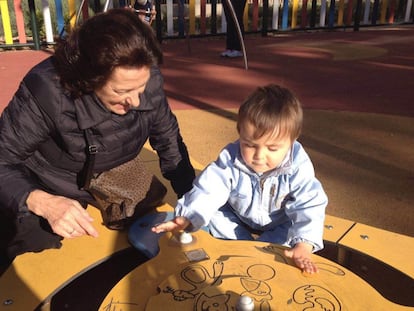The grandmother hypothesis: How humankind owes its success to matriarchs
The dependency of children favored longevity and reinforced cultural and biological change among humans

The world’s great civilizations were forged contrary to family instinct. The Chinese created an objective system to select civil servants who would put the state’s interests above those of their families; the Christian world prohibited marriage among its clergy with similar intent and the Ottomans set up an administrative elite made up of foreign slaves who could not pass on the privileges they acquired during their lives to their children. All of this was designed to limit the impulse to put family interests above general ones.
However, these measures had limited success. There were archbishops who fathered children and the Ottoman Janissaries eventually reversed the prohibition on passing power to offspring. Family always wins out, perhaps because the famiy instinct is so ingrained in human nature.
Children hold incredible potential, but for it to be developed they require a prolonged and intensive care that frequently their parents are unable to meet. We are dependent for many years after birth and it is likely that this has encouraged some typical traits in the species. Recently, the journal of the Proceedings of the National Academy of Sciences of the United States of America (PNAS) published a study carried out by Harvard University researchers that suggested that active grandparenting favored humans maintaining physical fitness long after their prime reproductive years and that also explained why exercise is so beneficial in later life. This role of grandparents as the pillars of parenting could be the reason why women, contrary to what occurs in practically every other animal species, can live for decades after losing their reproductive ability.
The success of species at large is reproductive, but ours achieved success with an increase in non-reproductive timeMaría Martinón Torres, director of Cenieh
The “grandmother hypothesis” was developed through the study of older female members of the Hadza people of northern Tanzania. Kristen Hawkes, of the University of Utah, observed that these women were extremely active in gathering food that they then shared with their daughters. This generosity was conducive to them being given more grandchildren. Years later, an analysis of pre-industrial societies in Canada and Finland reached similar conclusions. At the beginning of the 17th century in Quebec, ecclesiastical records made it possible to determine that women who lived in the same parish as their mothers on average had 1.75 more children than their sisters who lived further away. In Finland, the results showed a similar tendency, as long as the grandmother was not over the age of 75.
“Natural selection would have favored longevity in species made up of dependent individuals,” says María Martinón Torres, director of the Spanish National Center for Research on Human Evolution (Cenieh). Fragile human babies and their huge brains would have had more chance of survival and development thanks to their grandmothers and in turn their efforts would have given our species the reward of a much longer and healthier life span than that of our close relatives, such as chimpanzees. These animals, which remain fertile their whole lives, suffer serious physical decline in their 30s and rarely make it to 40.
The paleoanthropologist Marina Lozano notes that it is estimated this essential function in grandmothers began with Homo erectus, a species that emerged around 1.8 million years ago. “It is the first species of our genus to have a similar structure and life cycle to ours, with a more dilated growth in which lactation and childhood are separated and we have another stage, adolescence,” says Lozano, of the Catalan Institute of Human Paleoecology and Social Evolution.
It is probable that grandmotherly help began with human species that predated our own, but it seems that around 50,000 years ago cultural transformations occurred that intensified the phenomenon. According to calculations by Central Michigan University researcher Rachel Caspari, based on the fossilized teeth of 768 individuals who lived over the past three million years, among Homo sapiens during the Upper Paleolithic, the number of individuals surviving until an age when they could become grandparents was greatly increased. In that period, for every 10 Neanderthals who died between the ages of 15 and 30, only four lived longer. Among Homo sapiens, that number rose to 20.
Sapiens had already been on the planet for tens of thousands of years, but around 60,000 years ago something happened that increased their capabilities. “There is a palpable cultural sophistication; it is the age when hybridization with Neanderthals took place and it also when there was a migration out of Africa that coincided with migrations within the continent,” says Antonio Rosas, director of the Paleoanthropology Department at the National Museum of Natural Sciences in Madrid. “This period was unique, something was happening and it is clear that it was changing social and cultural organization, something that would also change the value of grandparenting.”
This capacity for cultural adaptation increased life expectancy among Homo sapiens, leading to larger numbers of grandparents in the population. Women are born with a number of egg cells that are distributed during their fertile years. On increasing life expectancy, there may have been a change that also increased the number of egg cells to maintain fertility for longer, but the presence of grandmothers without their own children to look after offered other advantages. Human females are among the few animal species that cannot reproduce until the end of their lives. The others are cetaceans with teeth, such as pilot whales, beluga whales, narwhals and orcas, which also have large brains.
During that period of reinforcing cultural and biological transformation, greater life expectancy would have been a driving force for the species, which after many millennia of survival was on its way to an unprecedented global expansion. “Increased life expectancy allows for an overlapping of generations that makes it possible to accumulate exceptional wealth. The Australopiths never knew their grandparents. Being able to bring together three generations in one home is a hive of knowledge that other species do not have. Humans do not have to start from zero with every generation. That completely alters the value of older people,” says Martinón Torres.
These societies, in which grandparents gained more and more importance, were responsible for artistic creations such as the cave paintings at Altamira in Spain and Lascaux in France. They were able to improve their hunting techniques and survived and prospered during the Ice Age in Europe, during which the Neanderthals disappeared. This peculiar species, that had been so fragile for so long, achieved its success in an almost paradoxical way, says Martinón Torres. “The success of species at large is reproductive, but ours achieved success with an increase in non-reproductive time.”
The developmental needs of the brain, the organ where intelligence resides, but above all the social skills of humans, changed other traits of human biology that at the same time reinforced cultural changes that transformed the planet. The childcare input of grandparents was one of the traits that defined human singularity. As on other occasions, the strength of the species was to be found among some of its weakest members.
Tu suscripción se está usando en otro dispositivo
¿Quieres añadir otro usuario a tu suscripción?
Si continúas leyendo en este dispositivo, no se podrá leer en el otro.
FlechaTu suscripción se está usando en otro dispositivo y solo puedes acceder a EL PAÍS desde un dispositivo a la vez.
Si quieres compartir tu cuenta, cambia tu suscripción a la modalidad Premium, así podrás añadir otro usuario. Cada uno accederá con su propia cuenta de email, lo que os permitirá personalizar vuestra experiencia en EL PAÍS.
¿Tienes una suscripción de empresa? Accede aquí para contratar más cuentas.
En el caso de no saber quién está usando tu cuenta, te recomendamos cambiar tu contraseña aquí.
Si decides continuar compartiendo tu cuenta, este mensaje se mostrará en tu dispositivo y en el de la otra persona que está usando tu cuenta de forma indefinida, afectando a tu experiencia de lectura. Puedes consultar aquí los términos y condiciones de la suscripción digital.
More information
Archived In
Últimas noticias
Most viewed
- Reinhard Genzel, Nobel laureate in physics: ‘One-minute videos will never give you the truth’
- Oona Chaplin: ‘I told James Cameron that I was living in a treehouse and starting a permaculture project with a friend’
- Pablo Escobar’s hippos: A serious environmental problem, 40 years on
- Why we lost the habit of sleeping in two segments and how that changed our sense of time
- Charles Dubouloz, mountaineering star, retires at 36 with a farewell tour inspired by Walter Bonatti











































